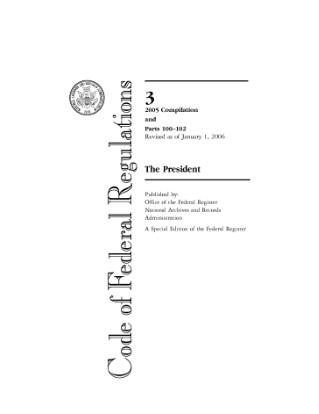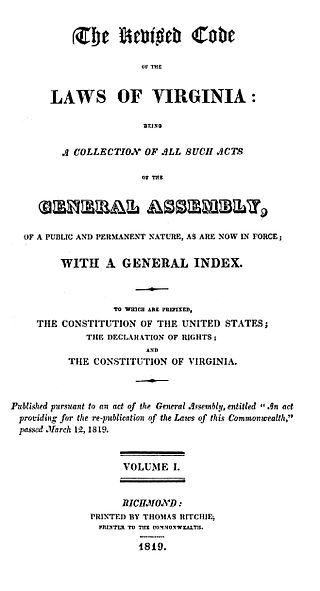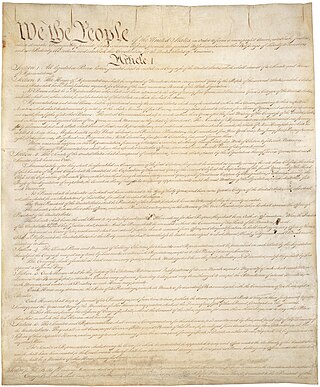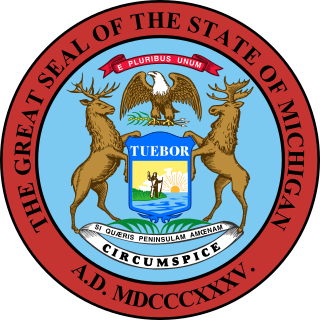Related Research Articles

The United States Code is the official codification of the general and permanent federal statutes of the United States. It contains 53 titles, which are organized into numbered sections.
An act of Congress is a statute enacted by the United States Congress. Acts may apply only to individual entities, or to the general public. For a bill to become an act, the text must pass through both houses with a majority, then be either signed into law by the president of the United States, be left unsigned for ten days while Congress remains in session, or, if vetoed by the president, receive a congressional override from 2⁄3 of both houses.
Promulgation is the formal proclamation or the declaration that a new statutory or administrative law is enacted after its final approval. In some jurisdictions, this additional step is necessary before the law can take effect.
In law, codification is the process of collecting and restating the law of a jurisdiction in certain areas, usually by subject, forming a legal code, i.e. a codex (book) of law.

In the law of the United States, the Code of Federal Regulations (CFR) is the codification of the general and permanent regulations promulgated by the executive departments and agencies of the federal government of the United States. The CFR is divided into 50 titles that represent broad areas subject to federal regulation.
A work of the United States government is defined by the United States copyright law, as "a work prepared by an officer or employee of the United States Government as part of that person's official duties". Under section 105 of the Copyright Act of 1976, such works are not entitled to domestic copyright protection under U.S. law and are therefore in the public domain.

The Archivist of the United States is the head and chief administrator of the National Archives and Records Administration (NARA) of the United States. The Archivist is responsible for the supervision and direction of the National Archives.

The United States Statutes at Large, commonly referred to as the Statutes at Large and abbreviated Stat., are an official record of Acts of Congress and concurrent resolutions passed by the United States Congress.

The Code of Virginia is the statutory law of the U.S. state of Virginia and consists of the codified legislation of the Virginia General Assembly. The 1950 Code of Virginia is the revision currently in force. The previous official versions were the Codes of 1819, 1849, 1887, and 1919, though other compilations had been printed privately as early as 1733, and other editions have been issued that were not designated full revisions of the code.
The Revised Statutes of the United States was the first official codification of the Acts of Congress. It was enacted into law in 1874. The purpose of the Revised Statutes was to make it easier to research federal law without needing to consult the individual Acts of Congress published in the United States Statutes at Large.

The law of the United States comprises many levels of codified and uncodified forms of law, of which the supreme law is the nation's Constitution, which prescribes the foundation of the federal government of the United States, as well as various civil liberties. The Constitution sets out the boundaries of federal law, which consists of Acts of Congress, treaties ratified by the Senate, regulations promulgated by the executive branch, and case law originating from the federal judiciary. The United States Code is the official compilation and codification of general and permanent federal statutory law.
Title 1 of the Code of Federal Regulations, titled General Provisions, is a United States federal government regulation.
The law of Colorado consists of several levels, including constitutional, statutory, regulatory, local, and case law. The Colorado Revised Statutes form the general statutory law.
The law of Virginia consists of several levels of legal rules, including constitutional, statutory, regulatory, case law, and local laws. The Code of Virginia contains the codified legislation that define the general statutory laws for the Commonwealth.
The law of Pennsylvania consists of several levels, including constitutional, statutory, regulatory and case law. The Pennsylvania Consolidated Statutes form the general statutory law.

The law of Michigan consists of several levels, including constitutional, statutory, regulatory and case law. The Michigan Compiled Laws form the general statutory law.
The law of North Carolina consists of several levels, including constitutional, statutory, regulatory, case law, and local law.
The law of Washington consists of several levels, including constitutional, statutory, regulatory and case law, as well as local ordinances. The Revised Code of Washington forms the general statutory law.

The Federal Register Modernization Act was a bill that would require the Federal Register to be published, rather than printed, and that documents in the Federal Register be made available for sale or distribution to the public in published form.
United States v. Young, 232 U.S. 155 (1914), is a United States Supreme Court case holding that the Criminal Code of 1909 does not require indictments for mail fraud to show that the fraudulent mailed statements were directly shown to the defrauded party.
References
![]() This article incorporates public domain material from websites or documents of the U.S. Government Publishing Office .
This article incorporates public domain material from websites or documents of the U.S. Government Publishing Office .
- ↑ Bast, Carol M.; Hawkins, Margie A. (2013). Foundations of Legal Research and Writing (5th ed.). Clifton Park, New York: Delmar. p. 138. ISBN 9781285402604.
- 1 2 Public and Private Laws: About, United States Government Printing Office , retrieved 2011-02-25,
Public and private laws are prepared and published by the Office of the Federal Register (OFR), National Archives and Records Administration (NARA). ...After the President signs a bill into law, it is delivered to the Office of the Federal Register (OFR), National Archives and Records Administration (NARA) where it is assigned a law number, legal statutory citation (public laws only), and prepared for publication as a slip law. ...At the end of each session of Congress, the slip laws are compiled into bound volumes called the Statutes at Large, and they are known as 'session laws.' ...Every six years, public laws are incorporated into the United States Code, which is a codification of all general and permanent laws of the United States. A supplement to the United States Code is published during each interim year until the next comprehensive volume is published.